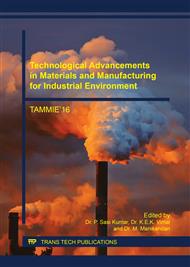[1]
Kumar et al, Optimization of pulsed TIG welding process parameters on mechanical properties of AA 5456 Aluminum alloy weldments, Materials and Design 30 (2009) 1288–1297.
DOI: 10.1016/j.matdes.2008.06.055
Google Scholar
[2]
Ajit Khatter et al, Optimization of Process Parameter in TIG Welding Using Taguchi of Stainless Steel-304, IJRMET Vol. 4, Issue 1, Nov 2013 - Apri l (2014).
Google Scholar
[3]
M. Balasubramanian et al, Effect of process parameters of pulsed current tungsten inert gas welding on weld pool geometry of titanium welds, Acta Metall. Sin. (Engl. Lett. ) Vol. 23 No. 4 pp.312-320 August (2010).
Google Scholar
[4]
Arun Narayanan et al, Influence of Gas Tungsten Arc Welding Parameters in Aluminium 5083 Alloy, International Journal of Engineering Science and Innovative Technology (IJESIT) Volume 2, Issue 5, September (2013).
Google Scholar
[5]
Indira Rani M et al, Effect of Pulsed Current Tig Welding Parameters on Mechanical Properties of J-Joint Strength of Aa6351, The International Journal of Engineering And Science (IJES) Volume 1 Issue 1 Pages 01-05 Nov 2012 ISSN: 2319–1813 ISBN: 2319–1805.
Google Scholar
[6]
P. Bailey, J. Champaigne, C. Long Ricochet peening, , The Shot Peener, Volume 27, 2013, pp.14-16.
Google Scholar
[7]
Y. Fouad and Mostafa M. El Metwally Effect of Shot Peening on High Cycling Fatigue of Al 2024-T4, , International Conference on Advanced Materials Engineering vol. 15 (2011).
Google Scholar
[8]
B.J. Foss, S. Gray, M.C. Hardy, S. Stekovic, D.S. McPhail, B.A. Shollock Analysis of shot-peening and residual stress relaxation in the nickel-based superalloy RR1000, ActaMaterialia, Vol. 61, 2013, p.2548–2559.
DOI: 10.1016/j.actamat.2013.01.031
Google Scholar
[9]
Kazuyuki Oguri Fatigue life enhancement of aluminum alloy for aircraft by Fine Particle Shot Peening (FPSP), Journal of Materials Processing Technology, Vol. 11, 2011, p.1395–1399.
DOI: 10.1016/j.jmatprotec.2011.03.011
Google Scholar
[10]
C.A. Rodopoulos, S.A. Curtis, E.R. de los Rios, J. SolisRomero Optimisation of the fatigue resistance of 2024-T351 aluminium alloys by controlled shot peening—methodology, results and analysis, , International Journal of Fatigue, Vol. 26, 2004, p.849.
DOI: 10.1016/j.ijfatigue.2004.01.003
Google Scholar
[11]
Ivo Cerny Growth and retardation of physically short fatigue cracks in an aircraft Al-alloy after shot peening, Journal of Procedia Engineering Vol. 10 , 2011 p.3411–3416.
DOI: 10.1016/j.proeng.2011.04.562
Google Scholar
[12]
Harold Luong, Michael R. Hill The effects of laser peening and shot peening on high cycle fatigue in 7050-T7451 aluminum alloy, Journal of Materials Science and Engineering , 2010, p.699–707.
DOI: 10.1016/j.msea.2009.08.045
Google Scholar
[13]
S. Curtis, E.R. de los Rios, C.A. Rodopoulos, A. Levers Analysis of the effects of controlled shot peening on fatigue damage of high strength aluminium alloys, , International Journal of Fatigue 25 (2003) 59–66.
DOI: 10.1016/s0142-1123(02)00049-x
Google Scholar
[14]
G.H. Majzoobi, K. Azadikhah, J. Nemati The effects of deep rolling and shot peening on fretting fatigue resistance of Aluminum-7075-T6, Materials Science and Engineering A 516 (2009) 235–247.
DOI: 10.1016/j.msea.2009.03.020
Google Scholar
[15]
A.L.M. Carvalho, H.J.C. Voorwald Influence of shot peening and hard chromium electroplating on the fatigue strength of 7050-T7451 aluminum alloy, International Journal of Fatigue 29 (2007) 1282–1291.
DOI: 10.1016/j.ijfatigue.2006.10.003
Google Scholar
[16]
X. Song, W.C. Liu, J.P. Belnoue, J. Dong, G.H. Wu, W.J. Ding, S.A.J. Kimber, T. Buslaps, A.J.G. Lunt, A.M. Korsunsky An eigenstrain-based finite element model and the evolution of shot peening residual stresses during fatigue of GW103 magnesium alloy, International Journal of Fatigue 42 (2012).
DOI: 10.1016/j.ijfatigue.2012.01.019
Google Scholar
[17]
Kyun Taek Cho, Kyung Song, Sang Ho Oh, Young-Kook Lee, Kyoung Mook Lim, Won Beom Lee Surface hardening of aluminum alloy by shot peening treatment with Zn based ball, Journal of Materials Science and Engineering A 543 (2012) 44– 49.
DOI: 10.1016/j.msea.2012.02.043
Google Scholar
[18]
S. Sathyajith, S. Kalainathan Effect of laser shot peening on precipitation hardened aluminum alloy 6061-T6 using low energy laser, Journal of Optics and Lasers in Engineering 50 (2012) 345–348.
DOI: 10.1016/j.optlaseng.2011.11.002
Google Scholar


